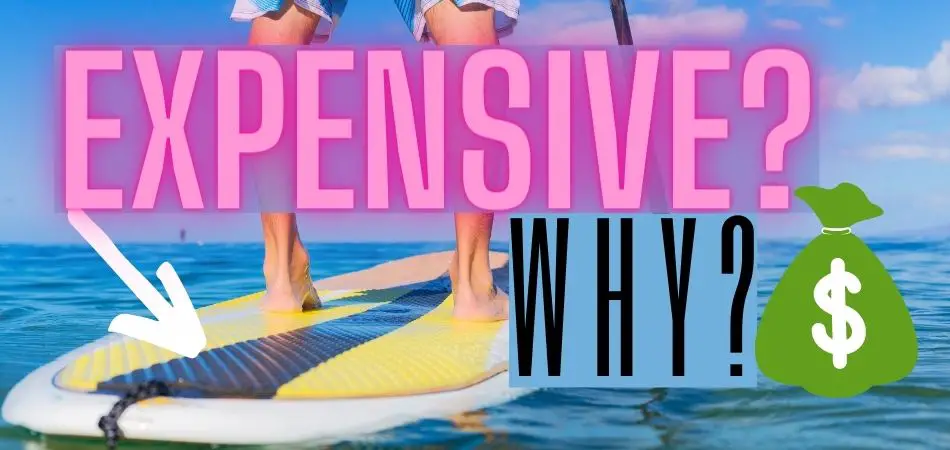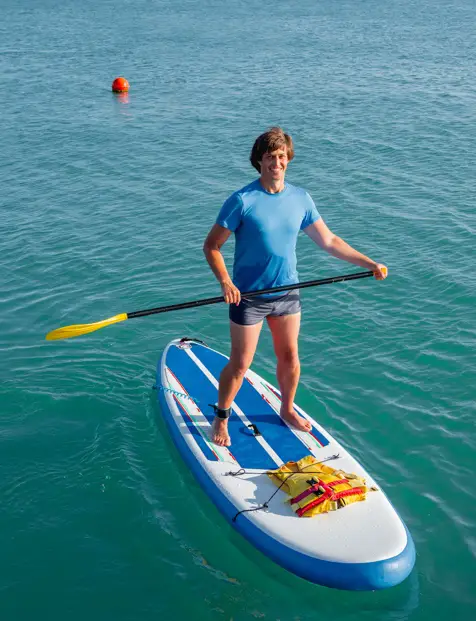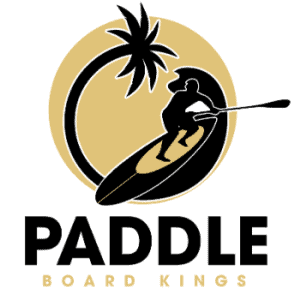You might be wondering, why are paddle boards so expensive? There are many reasons for this. paddle board prices vary depending on the materials used, their quality, and how much technology is incorporated into these boards.
The cost also varies depending on where you purchase your board- whether it’s a retailer or online marketplaces like Amazon or eBay. Whatever your reason for wanting to know more about paddle board costs, we are here to help.

Here are seven reasons paddle boards are so expensive:
1. Construction method and materials
The construction methods of paddle boards influence the price. The more expensive boards are made with lightweight, durable materials like carbon fiber or Kevlar. Boards built with these materials will be lighter and stiffer then fiberglass boards (the most common construction material).
Also, you will notice that more material is used in making paddle boards than, say, surfboards. This is because surfboards only need to keep their shape in the water, but paddle boards need to hold you up and provide a wide base for balance. In addition, the board needs to be strong enough so that it doesn’t crack or break during use. This makes their price higher.
2. Type of technology used on your SUP (eSUPs)
Price varies depending on how much technology goes into each stand-up paddle board model. For example, if you want an inflatable standing board with a built-in pump, this will cost more than other models without such features.
The most expensive model includes all the bells and whistles, plus:
- Carbon fiber construction material
- High-tech deck pad similar to those found in skateboarding shoes
- Sturdy carry bag
- Leash plug for a bungee cord
- Built-in paddle holder
3. Paddle Board Size
Paddle boards come in a variety of sizes, and the larger boards will cost more than smaller ones. The bigger models are also wider, making them less agile for paddling but easier to balance on top of the water (especially if you’re heavier).
4. The wood veneer used in some paddle boards
Wood veneers such as those made from pine or bamboo are strong, light, and flexible. They are perfect for pro boards because they give more pop and durability than other veneers, making them stiffer but less durable (i.e., harder to repair). Paddle boards with such wood veneers are usually priced slightly higher than other boards.
5. The wood grain of the deck pad used in your SUP
Some paddle boards come with a wooden-like or cork surface instead of an EVA foam grip like most inflatable stand-up paddle boards have on their deck pads. This is usually found on professional models that can cost $1500+.
These types of paddling board grips are pricier because of how labor-intensive it is to make this type of material compared to regular plastic ones. Also, high-tech materials such as carbon fiber are expensive too.
6. Performance of the paddle boards
The performance of the paddle board affects its price. The better it performs, the higher your investment will be. Most common models of stand-up paddling boards provide a good balance between cost and performance with ease of maneuverability in mind.
Boards that perform well are usually stiffer than those that don’t have superior tracking qualities or speed (this depends on how much rocker there is). The better the performance, the pricier the board.
7. The distribution costs
You are most likely going to buy your paddle board from a local retailer or online marketplace. This means you will need to pay the listed price plus shipping and handling charges, making your paddle board more expensive than if it was purchased in bulk from a wholesaler or manufacturer (again, without any middlemen).
Paddle Board Price Ranges
A good paddle board from a reputable brand will cost about $300 to $600. These boards are usually made with lower-grade materials, but they can still deliver good performance and value for their price range.
A solidly performing paddle board will cost between $900 and $1500. Boards in this category are usually made with higher-grade materials and technology that enhance performance but can be bulky to transport or store.
Racing paddle boards for flatwater racing (for advanced paddlers) go from about $1600 up, depending on the type of construction material used.
They are fast and flexible – what you need if you’re serious about competing against other experienced racers because they will give you an edge over your competitors who use less expensive boards.
paddle board yoga models cost between $300 and $1000; it depends on how much padding is incorporated into their deck pads plus whether or not they have carrying bags included as part of the package price.
More expensive SUPs such as those built with carbon fiber construction materials (i.e., lighter boards but more expensive to purchase) usually cost between $1500 and $4000.
The best stand-up paddleboards with carbon decks can be found in the high range, above $5000. These models have all of the features mentioned earlier, plus other bells and whistles like graphics on their decks or special carrying cases/bags included as part of their standard package price, so you don’t have to pay extra for them separately.
Stand-up paddle board rental rates vary depending on what kind of location they’re rented from, where they will be stored, how many people use them during a single session, etcetera.
Board rentals in Hawaii can go for as low as 25 bucks per hour or up to $75 for a full day, depending on the location and time of year. Board rentals in places like California are usually priced less than rental rates in Hawaii, even though these locations can cost more during their respective peak seasons.
Are Paddle Boards Worth The Money?

Yes. Paddle boards will give you a lot of benefits and can be used for various purposes.
Paddle boards will help get your cardio up, improve your balance, give you an excellent core workout, and tone muscles throughout the body. It is also helpful to those with joint issues because it provides a low-impact exercise that doesn’t put excessive pressure on their joints.
Paddling helps increase cardiovascular endurance without putting unnecessary stress on the spine or hips (as long as proper form & alignment are followed). Stand-up paddle boarding improves mental health by providing much-needed relaxation time in nature away from technology and all its distractions.
The sport is also fun to do with others and can be a great way to make new friends, which is one of the many reasons it has been growing in popularity over recent years.
Paddle boards are worth every penny because they offer so many benefits for your mind & body while also being an enjoyable activity that you can enjoy solo or with other people (the more, the merrier).
Cheap vs. Expensive Stand-Up Paddle Boards?
Choosing between a cheap vs. expensive SUP can be a tough decision to make. You have to consider what your specific needs are and how much money is available for the purchase.
If you’re just beginning stand-up paddle boarding, getting a cheaper or mid-range model will probably work best.
It doesn’t need to be as high quality as an advanced version that has been built with more resilient materials (i.e., carbon fiber), so they should last longer than their pricier counterparts since they usually only cost about $1000+ depending on where you decide to buy them from.
Paddle boards that come in at under $500 won’t perform well over time and won’t last nearly as long either.
It’s always recommended to buy a more expensive paddle board because it will provide you with better performance capabilities, which means your fun and workouts on the water can be taken to new heights.
If money is no object for you and you’re looking into getting the best stand-up paddle boards possible (that have been built with high-quality materials such as carbon fiber), then consider spending $3000+ instead of going cheap.
You’ll get what you pay for in this case since there are so many benefits that come along with owning an advanced SUP board, like having increased speed due to their lower weight. They’re easier to carry around when needed, thanks to being lighter than less pricey models.
You will also need to consider where you will be storing your board and how much space is available in the storage unit. If it’s going to take up a lot of room, then that means paying more for something like an advanced carbon fiber SUP may not make sense.
They’re quite large & bulky, so you won’t have anyplace else to store them other than out on display where they stand upright.
They are easy enough to move around if need be but keep in mind that these boards can weigh upwards of 70 pounds depending on their features (i.e., deck pad vs. no-pad; compartments with or without bulkheads/pockets). This makes it somewhat difficult, especially when transporting them back & forth from the water using one hand.
Conclusion
Paddle boards can be expensive, but in most cases, it’s worth the price because they are an excellent way to improve balance and strengthen muscles. It can also be a fun activity that you can enjoy with family members or friends for many years.
